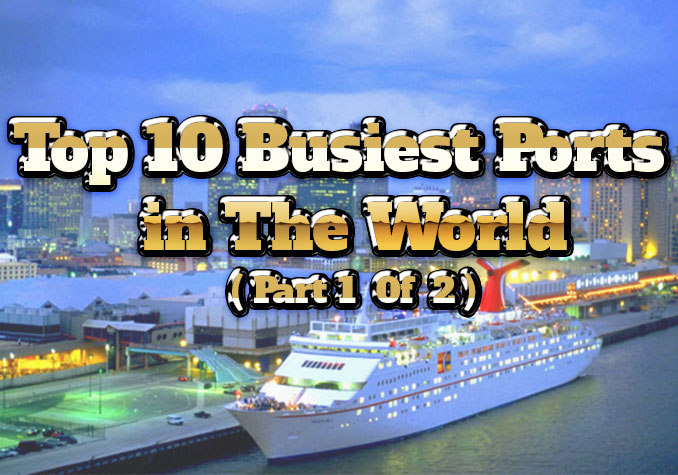China leads the game of world’s busiest ports as our list has more than half cargo ports owned by the Republic of China
China leads the seaports business race and sits at more than half of the top 10 ports, however, remaining are also in the dominance of China to some extent e.g. Singapore port and South Korean ports. Europe has only one port on the list of top ten and it is from Netherlands. There is not even a single port from rest of the world’s economic leaders e.g. the UK, the USA, or Australia.
Shipping ports are still playing the vital role in the transportation mean of world’s oldest source of cargo shipping and are the ultimate destinations for the ships to deliver cargo. World order of transportation and trade between the countries has been changed quickly and cargo urgency has been shifted from Europe and U.S.to China and Asia Pacific neighborhood. In the past century, 90 percent of trade was towards U.S. and the UK along with other European countries, but from the end of the 20th century, this trend has been shifted towards the Asian Pacific international locations together with China, Singapore, South Korea and Japan.
These countries along with Indian continent are ruling the sector of sea cargo. They possess world’s largest and busiest ports and the majority of the biggest and the busiest sea ports in the chinese neighborhood and only one port which ranks in the list of busiest ports is from Europe.
Greatest ports in the world are as follows.
Shanghai Port
Shanghai port is the largest shipping port on the globe and is situated in natural river flow in the delta of the Yangtze River in the west of China. It is a most important port for international exchange seeing that it’s headquartered to the numerous industrial units attached to Anhui, Jiangsu, Henan and Zhejiang provinces. For the first time in 2010, the Shanghai port was declared the busiest and the largest seaport on the planet earth. The Shanghai port beat the Singapore port and managed to handle more than 500 million ton of cargo along with 29.05 million TEU’s container cargo leaving Singapore’s port behind with more than half a million container cargo and around 30 million ton of other cargo. In 2014, Shanghai port set a world record for dealing with over 35 million TEU’s.
The port is positioned at the delta of the Yangtze River and has a field area of 3,619km². Shanghai International Port Group (SIPG) owns the port facility. Wusongkou, Waigaoqiao, and Yangshan are the three major container port facilities. The port contains one hundred and twenty-five berths with a complete quay size of about sixteen miles. It serves 2,000 container ships or much more centered measurement, every month and bills for a quarter of China’s total international trade and cargo transport. Its a gigantic port by size, functionality, and operations.
Cargo Throughput: 550 million tons
Anchorage depth: 7.1m – 9.1m
Cargo pier depth: 3.4m – 4.6m
Oil terminal depth: 9.4m – 10m
Drydock: very Large
Harbor size: very Large
Railway size: Large
Harbor type: River Natural
Max size: Up to 500 feet in length
Repairs: Major
Shelter: Good
Port of Singapore
The Port used to be built in 1819, the Singapore Port often called a monetary backbone because of Singapore’s lack of land and normal resources. The port plays an essential position within the importation of common assets, and the re-exporting of particularized merchandises, for example, wafer production or oil filtering to generate income. Hundreds and hundreds of ships from throughout the globe use the Port of Singapore, connecting the port with more than 600 different ports in 123 nations throughout six unique continents. The Port of Singapore handled 537.6 million tonnes of cargo carrier in 2012, is the second biggest port of the arena. The port’s container dealing with potential crossed 30 million TEUs mark for the first time in 2012. The port terminals are located at Keppel, Brani, Tanjong Pagar, Sembawang, Pasir Panjang, and Jurong. The terminals are managed via Port of Singapore Authority PSA Singapore and Jurong Port. The port receives a normal of one hundred forty thousand containers on yearly basis and connects to 600 ports globally. It is equipped with 204 quay cranes and a number of gantry cranes.
Controlled and managed by; Maritime and Port Authority of Singapore (MPA)
Cargo Throughput: 538 million tons
Anchorage depth: 9.4m – 10.2m
Cargo pier depth: 3.4m – 4.6m
Oil terminal depth: 11.2m – 12.2m
Dry dock: Large
Harbor size: very Large
Railway size: Large
Harbor type: Natural coastal Deep water sea port
Max size: Up to 500 feet in length
Repairs: Major
Shelter: excellent
Tianjin Port
One of the vital ports of China is the Tianjin port on the Bo Hai Sea and it is connected to 21 different adjacent cities and provinces via its dry port. Tianjin is placed in the neighborhood of Beijing and the north central provinces, so Tianjin is competent to duvet more areas of China than any other port. It is more energetic than another port in China but shanghai port handles extra cargo that the Tianjin port from the very North West in Xinjiang. It is the 2d largest port in China and the third biggest port on the earth. This port is currently known as the Port of Tianjin, at the same time formerly it was once known as the Tanggu. It treated 525 million tonnes of cargo. The Tianjin port is based in the mouth of Haihe River and has a size of 131km². A black chapter in the historical past of ports has been written when in 2015 the Tianjin port environment was spoilt via the chemical explosions. It was once an unlucky weekend of August. Two explosions blasted the area and entire area used to be protected in black smoke, triggered with the aid of an overheated container of dry nitrocellulose, initiated the catastrophe in a container storage station near the port in the storage facility. This incident leaves 1000’s of injured and several useless even as the loss of the property was more than expectations.
The Tianjin port connects to 500 plus ports across the globe which can be located in additional than 189 international locations across the globe. Tianjin Port is operated by using the Tianjin port authority. The Tianjin port isn’t a normal port as it has greater than 159 berths and is headquartered on the southern harbor, the south-east vicinity, Dongjiang Port, the northern port, a fiscal zone within the southern region and other auxiliary harbours. This record also ends with a China-funded port. The Tianjin port managed around 15 million TEU tons of container cargo and a 525 million tons of total cargo throughput on 12 months bases, a colossal upward thrust in evaluation with the years earlier the place in 2012, it has managed 12 million TEUs.
Water location: Bo Hai Hi Sea (Sea)
Cargo Throughput: 525 million tons
Anchorage depth: 7.1m – 9.1m
Cargo pier depth: 7.1m – 9.1m
Oil terminal depth: 4.9m – 6.1m
Dry dock: Large
Harbor size: Small
Railway size: Large
Harbor type: River Natural
Max size: Over 500 feet in length
Repairs: Limited
Shelter: Excellent
Port of Ningbo-Zhoushan
Ningbo-Zhoushan port is a specifically designed for dealing with raw materials and is used in general for the supply of manufactured items and cargo throughout the Chinese area. This port has an importance for import and export of China. The Port of Ningbo-Zhoushan, China, is with a mixed potential of 873 million lots cargo on every year bases and the busiest in the world when watching at cargo tonnage. This was carried out after the port completed the merger with the neighboring Zhoushan Port crew in 2015.
Cargo Throughput: 873 million tons
Anchorage depth: 7.1m – 9.1m
Cargo pier depth: 4.9m – 6.1m
Oil terminal depth: 4.9m – 6.1m
Dry dock: Small
Harbor size: Small
Railway size: Small
Harbor type: River Natural
Max size: Over 500 feet in length
Repairs: Moderate
Shelter: Good
Guangzhou Port
Guangzhou port regularly transports cargo to and from nearby Jiangxi, Sichuan, Guangxi, Guizhou, and Yunnan Provinces. The Guangzhou port identical to the port of Ningbo handles machinery and it has distinctive arrangements for dealing with heavy machinery like agricultural, industrial and manufactured machines. The Port of Guangzhou dealt with around four hundred million tonnes of cargo every year, making it the fourth biggest port on this planet. The port is placed in the center of the Pearl River Delta. It’s operated with the aid of the team of Guangzhou Port Authority and cross the one hundred million tons mark for the first time in 2000., and it was the rise of the port. This port has a current throughput of just under 500 million plenty each year.
The port comprises four critical areas including Downtown Port, Xinsha Port, Huangpu Port and Nansha Port restraints. This present day, the port is a without doubt one of the biggest port in the country that handles ores and coal. It is the greatest loading and clearing port for coal in China. Port of Guangzhou is the essential seaport of the city of Guangzhou, Guangdong province, China.
The port also serves the splendid buying and selling hub on the Pearl River Delta neighborhood and Guangdong province. It is usually foremost transport hub for industries positioned in neighboring provinces such as Guangxi, Guizhou, Yunnan, Hubei , Hunan, Sichuan and Jiangxi. This port has been redesigned to control 100,000 tons cargo carriers.
Water location: Xi River (River)
Cargo Throughput: 490 million tons
Anchorage depth: 4.9m – 6.1m
Cargo pier depth: 12.5m – 13.7m
Oil terminal depth: 4.9m – 6.1m
Dry dock: Medium
Harbor size: Medium
Railway size: Small
Harbor type: River Natural
Max size: Up to 500 feet in length
Repairs: Major
Shelter: Good













